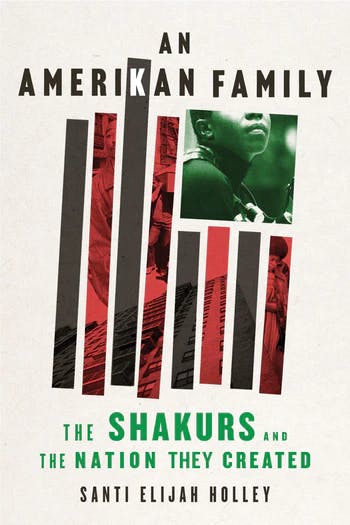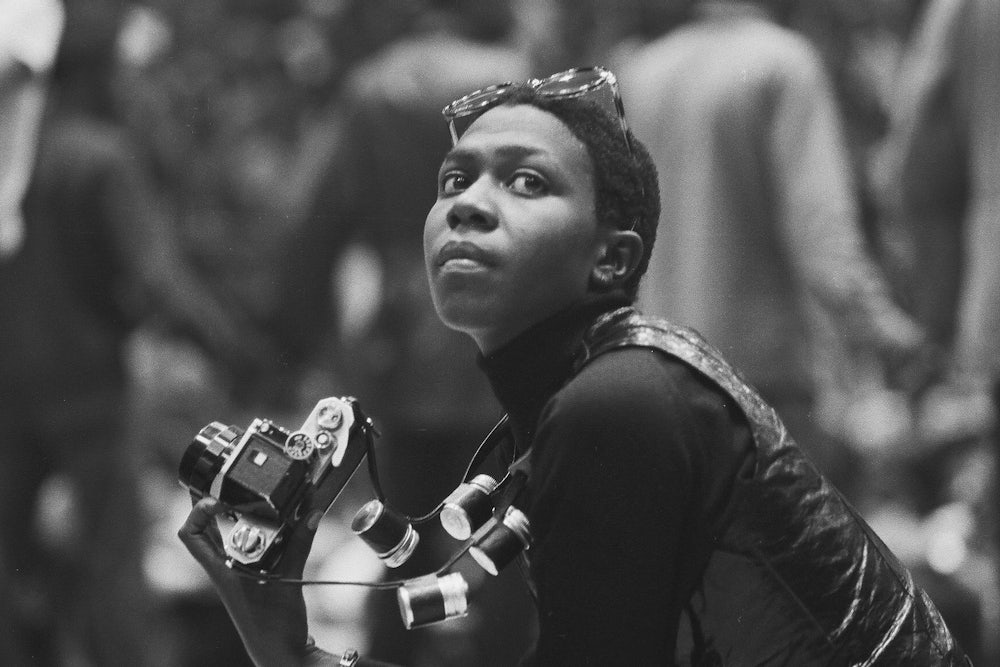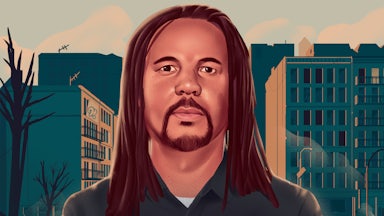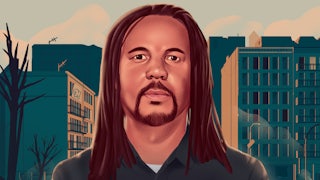Asked to identify the most influential families in the United States, many Americans might name the Rockefellers, the Vanderbilts, or the Fords. These families, like many others, have been instrumental in shaping American life, politics, and culture—primarily because of their enormous fortunes and expansive philanthropic work.
In An Amerikan Family: The Shakurs and the Nation They Created, journalist Santi Elijah Holley highlights the often-overlooked contributions of a different “close-knit family, based predominantly in New York City”: the Shakurs. They include Salahdeen Shakur, a leader in the Revolutionary Action Movement, a student-led Black nationalist group; his two sons, Lumumba and Zayd, leaders of the Black Panther Party in Harlem; and revolutionary activists Assata Shakur and Afeni Shakur (the mother of the famous rapper Tupac Shakur).

Unlike other prominent American families, the Shakurs did not have millions of dollars to establish universities and foundations in their name. But what they did create was a powerful legacy of resistance. The Shakurs committed themselves to the cause of Black liberation and challenged white supremacy in the face of intense government repression, through various revolutionary groups, including the Revolutionary Action Movement, the Black Panther Party, and the Black Liberation Army. At every step, they worked to empower Black communities across the nation—often filling in the gaps left open because of the inattention and indifference of American leaders.
While some of the Shakurs (Arabic for “thankful”) were related by blood, others were chosen members of the family. What drew them together was their global political vision and praxis, deeply rooted in a history of resistance to oppression. They maintained a belief in Black radical politics and the possibility that systems of oppression could be overturned. Following the example of Malcolm X, who adopted the last name “X” to signal the loss of his family’s original African name, they chose the last name “Shakur” as a sign of their commitment to the global Black freedom struggle.
An Amerikan Family is above all a beautiful tribute to the Black family. The Black family as an institution has been targeted by the state since the era of slavery and is too regularly an object of derision in American society today. By telling the story of the Shakurs, Holley offers a much-needed corrective by highlighting the strength, resilience, and power of the Black family. And while there have been assorted books about and by individual members of the family, understanding the Shakurs as a group centers on one crucial aspect of the Black family we too often overlook: the significant role it plays as incubator for activism. Indeed, An Amerikan Family provides a window into how political ideas are often developed and circulated within families—sometimes providing the glue that holds them together.
The group’s patriarch, Salahdeen Shakur, was born James Coston sometime around 1919. He went on to serve in the Navy and later adopted his new name after converting to Islam. In the mid-’60s, during the height of the Civil Rights–Black Power era, he began to gather a community of Black activists at his home in Jamaica, Queens. Building on the teachings of his associate Malcolm X, Salahdeen taught the core tenets of Islam and advocated Pan-Africanism, African pride, self-defense, economic self-sufficiency, and self-determination. For many, Salahdeen was a father figure. One activist, Bilal Sunni-Ali, explained that “our biological parents understood that we had somebody who we called Abba, because of the special relationship that they had with the struggle.”
Salahdeen’s biological sons, Lumumba and Zayd, embraced the values their father taught, which they later advanced as leaders of the Harlem chapter of the Black Panther Party. Established in the spring of 1968, the Harlem chapter worked to address poverty, educational inequality, and inadequate housing. In one instance, the chapter helped to get a Black principal hired at a predominantly Black school in Harlem. It also provided educational resources for welfare recipients throughout the city—outlining their rights as citizens.
The Black Panther Party in Harlem drew a significant following of young Black men and women looking for meaningful change. Afeni Shakur, former leader of a street gang, was one of these recruits. Born Alice Faye Williams in 1947 in Lumberton, North Carolina, she had already adopted her new first name, Afeni—meaning “dear one” or “lover of people” in Yoruba—in 1966. When she heard a speech by Bobby Seale, co-founder of the Black Panther Party, in Harlem two years later, she felt compelled to learn more. The Shakur men welcomed her with open arms into the family and extended to her a level of kindness and respect she had not previously experienced. “Never in my life had I met men who didn’t abuse women,” Afeni explained in Jasmine Guy’s 2005 biography, Afeni Shakur: Evolution of a Revolutionary.
In the fall of 1968, Afeni married Lumumba. The two worked closely together to provide adequate housing for Black residents in New York City, helping tenants organize rent strikes. “The couple were equal partners in the party,” Holley explains, “challenging each other as often as they challenged the system.” Yet this joint commitment also made them both targets for the federal government, which was actively working to dismantle the Black Panther Party. The FBI conducted mass surveillance of radical groups, including the Panthers. One of the FBI’s strategies was to arrest activists on trumped-up charges—often filled with accusations that could not be substantiated—to tie up movement leaders and drain their resources. Just months into their marriage, Lumumba and Afeni were arrested, along with 19 other activists in the city.
Prosecutors accused the Panther 21, as the group became known, of placing a bomb at two police stations—one in the Bronx and one in Manhattan—and at a Board of Education office in Queens in January 1969. During the trial, the Panthers learned their group had been infiltrated by undercover officers several months earlier. Much of the case hinged on their surveillance and reporting.
As the group awaited trial, Afeni spent two years in the New York Women’s House of Detention, where she formed close relationships with queer Black women. Holley highlights Afeni’s close bond with Carol Jean Crooks, known as “Crooksie,” a Black queer inmate from Brooklyn who took Afeni under her wing. Crooksie treated Afeni like family, ensuring she was well cared for and protected in the prison. According to Holley, it was Crooksie who provided Afeni with “clean, pressed clothes so as to look smart and respectable in the courtroom.” “If the men in the Black Panther Party had been the first to give Afeni a feeling of respect and protection,” Holley writes, “it was the women—particularly the queer women—who now offered her that security.” This brief statement offers one of the few discussions of gender or sexuality in the book.
Unlike Afeni, who had married into the family, Assata Shakur was one of the Shakurs who were not related by blood or marriage. Born JoAnne Deborah Byron in Brooklyn Women’s Hospital in 1947, she grew up in a loving and supportive family that deeply valued education. Holley describes her grandparents as being part of the “Talented Tenth,” a term W.E.B. Du Bois used to describe the group of college-educated African Americans he charged with leading the Black race after Reconstruction.
As a student at the City College of New York, she befriended a group of activists, including Black nationalists and Black Muslims, attending campus protests and engaging in discussions of anti-colonialism and imperialism. But it was not until the late 1960s, when Assata relocated to the Bay Area, that she became involved with the Black Panther Party, visiting the group’s headquarters and even assisting with the distribution of the party’s newspaper. Upon returning to New York City in the summer of 1970, while the Panther 21 trial was still underway, she joined the Harlem chapter, selling newspapers, serving free breakfast to local children, and providing medical assistance (such as administering free sickle-cell anemia and tuberculosis tests) to residents in the community.
During her time in the party, she developed a close friendship with Lumumba’s brother, Zayd Malik Shakur. But as the party began to fracture under the weight of government repression, which included actively facilitating infighting among members and chapters, Assata began to question her decision to join. More significantly, she held differing views from other party leaders who seemed to be becoming more dogmatic than practical. “This Party was a lot different from the Black Panther Party I had fallen in love with,” Assata explained in her 1987 autobiography. “The beautiful revolutionary creativity I had loved so much was gone. And replaced by dogmatic stagnation.” When she brought these doubts to Zayd, he walked out of Assata’s apartment without so much as offering consolation or concern.
The experience confirmed Assata’s decision to part ways with the party, and she went on to join the Black Liberation Army, an underground Black nationalist and Marxist group that advocated revolutionary armed struggle. Though there is little documentation of Assata’s BLA activities, she faced a series of criminal accusations and charges, including robbery, assault, and possession of a deadly weapon. Her life was forever changed when she was arrested on the night of May 2, 1973, following a violent shootout with police on the New Jersey Turnpike. The incident drew significant media attention and before long Assata Shakur, the revolutionary turned icon, became a household name. In a July 4, 1973, address, “To My People,” written in prison, Shakur denounced the U.S. government and condemned racism and inequality. “I have declared war on the rich who prosper on our poverty, the politicians who lie to us with smiling faces, and all the mindless, heartless robots who protected them and their property.” “I am a black revolutionary,” she continued, “and as such I am the victim of all the wrath, hatred and slander that amerikkka is capable of.” Shakur’s remarks were broadcast on local stations and reprinted in the Black Scholar, a preeminent journal of Black studies.
In 1977, Assata was convicted of the first-degree murder of a white state trooper during the shootout and sentenced to life in prison. Two years later, she escaped with the assistance of fellow BLA members and is currently in exile in Cuba. Though she was vilified in the white media, Assata Shakur emerged as an inspirational figure—and an international symbol—of Black radical resistance to oppression.
In the aftermath of the trial of the Panther 21, Afeni’s life took a myriad of twists and turns. While she was out on bail in the summer of 1970, she had a relationship with Billy Garland, a Black Panther activist from New Jersey. While fighting for her freedom during the trial, Afeni found out she was pregnant. One month after the acquittal, she gave birth to her son, Tupac Amaru Shakur.
Drawing on her experience in the Panther 21 trial and her subsequent work as a paralegal with Bronx Legal Services, Afeni provided legal assistance for several activists. Though she had limited formal education and no prior legal training, Afeni had represented herself during the trial. Holley details her legal acumen and describes her as a skilled cross-examiner, which played a crucial role in her acquittal. According to Holley, she was able to get one of the undercover officers to admit that “beyond a lot of grandiose talk, he hadn’t seen her or any of the other defendants committing any criminal act.”
While the arrival of her son marked a high point in her life, Afeni struggled during these years. The tight-knit community that had once helped sustain her was coming apart: “Her comrades were in jail, turning against each other, or going underground to engage in guerilla warfare,” Holley explains. During this period, Afeni began to abuse alcohol and drugs.
In the summer of 1984, Afeni relocated to Baltimore with the help of relatives. She continued to struggle to find her footing even as her teenage son began to find his calling. Holley details the early political activism of a young Tupac, who once canvassed from door to door in Baltimore with his girlfriend, Mary Baldridge, to warn of the dangers of gun violence and teen pregnancy. Inspired by his mother, Afeni, Tupac was determined to speak out against injustice in the Black community. Rap became the primary medium through which he addressed a range of social issues, including racism and police brutality. It was also the method through which Tupac advanced “the message of Black empowerment, self-determination, and liberation”—Black nationalist and radical ideas other members of the Shakur family endorsed.
Tupac’s path, however, was far more complicated and, at times, conflicted. Holley discusses Tupac’s controversial decision to get “THUG LIFE” tattooed across his abdomen in 1992. By then he was already a superstar, having released his first album, 2Pacalypse Now in 1991 and starred in the movie Juice. Members of the activist community, including his stepfather, Mutulu Shakur of the BLA, questioned the rationale of Tupac’s decision. The rapper would explain he was not endorsing criminal activity but addressing the neglect and violence children experience in American society. According to Tupac, he used “THUG LIFE” as an acronym to mean “The Hate U Give Little Infants Fucks Everybody.” “I don’t understand why America doesn’t understand Thug Life,” he later explained. “America is Thug Life.”
His explanation did not stop critics from arguing that the rapper was simply advocating violence, as many pointed to Tupac’s own activities and embrace of gang culture. According to Holley, Tupac was not affiliated with a gang but chose to “mimic gang culture” by displaying gang symbols, often as tattoos and wearing clothing that represented the Bloods as well as the Crips. Holley recounts Tupac’s abuse of alcohol, bouts of rage, and drug use in the years leading up to his untimely death at the age of 25, as he fought “a battle between motivation and fatalism, between self-determination and self-destruction.”
Holley covers some members of the family—notably Afeni and Assata—with more nuance than others. Although he provides rich details about Black women in the Shakur family, the book gives little consideration to the differences between the experiences of men and women. Readers unfamiliar with the history of the Black Panthers might be left with the impression that the party was always a haven for Black women, rather than yet another site of contested gender roles, misogynoir, and violence, as Panther leader Elaine Brown recounts in A Taste of Power. And even with a focus on luminaries such as Afeni and Assata Shakur, the book does not delve into women’s leadership in Black nationalist movements or explore their political theorizing—the unique ideas and strategies they developed and advanced within these activist spaces.
Yet Holley’s book represents the most detailed account of the Shakurs to date. Despite some of the book’s unevenness, An Amerikan Family opens an important conversation about Black resistance to oppression in U.S. history. “Regardless of what words or sentiments you immediately associate with the Shakur name, one word is indisputable: resilience,” Holley writes. He points to how activists today draw on the work and ideas of members of the Shakur family, noting, how Tupac’s song “Changes” became an anthem for Black Lives Matter protesters following the murder of George Floyd. He sees the legacy of the Shakur family endure “anywhere people are organized, committed, and dedicated to the struggle to improve the lives of Black people then and now.”
I would add that the legacy is also tied to the significance of the Black family in American life and culture. In a white supremacist society, where Black people are still fighting for full freedom, the Black family offers a buffer of protection and, at times, a space for resistance. This is the enduring legacy of the Shakur family—illuminating the power of the Black family in the ongoing fight for Black rights and freedom in the U.S. and across the globe.






